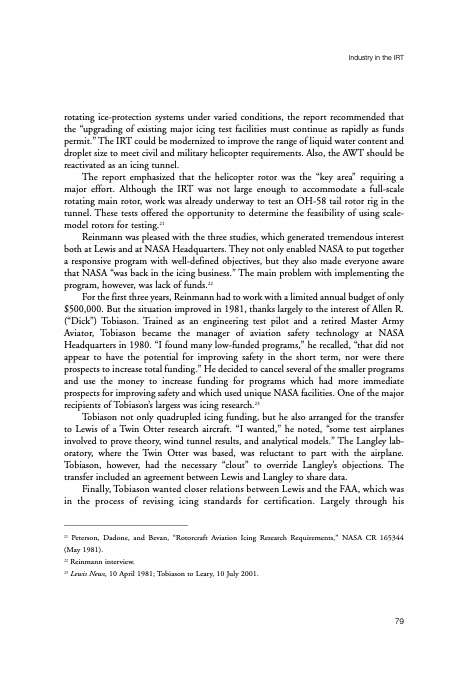
PDF Publication Title:
Text from PDF Page: 091
rotating ice-protection systems under varied conditions, the report recommended that the “upgrading of existing major icing test facilities must continue as rapidly as funds permit.” The IRT could be modernized to improve the range of liquid water content and droplet size to meet civil and military helicopter requirements. Also, the AWT should be reactivated as an icing tunnel. The report emphasized that the helicopter rotor was the “key area” requiring a major effort. Although the IRT was not large enough to accommodate a full-scale rotating main rotor, work was already underway to test an OH-58 tail rotor rig in the tunnel. These tests offered the opportunity to determine the feasibility of using scale- model rotors for testing.21 Reinmann was pleased with the three studies, which generated tremendous interest both at Lewis and at NASA Headquarters. They not only enabled NASA to put together a responsive program with well-defined objectives, but they also made everyone aware that NASA “was back in the icing business.” The main problem with implementing the program, however, was lack of funds.22 For the first three years, Reinmann had to work with a limited annual budget of only $500,000. But the situation improved in 1981, thanks largely to the interest of Allen R. (“Dick”) Tobiason. Trained as an engineering test pilot and a retired Master Army Aviator, Tobiason became the manager of aviation safety technology at NASA Headquarters in 1980. “I found many low-funded programs,” he recalled, “that did not appear to have the potential for improving safety in the short term, nor were there prospects to increase total funding.” He decided to cancel several of the smaller programs and use the money to increase funding for programs which had more immediate prospects for improving safety and which used unique NASA facilities. One of the major recipients of Tobiason’s largess was icing research.23 Tobiason not only quadrupled icing funding, but he also arranged for the transfer to Lewis of a Twin Otter research aircraft. “I wanted,” he noted, “some test airplanes involved to prove theory, wind tunnel results, and analytical models.” The Langley lab- oratory, where the Twin Otter was based, was reluctant to part with the airplane. Tobiason, however, had the necessary “clout” to override Langley’s objections. The transfer included an agreement between Lewis and Langley to share data. Finally, Tobiason wanted closer relations between Lewis and the FAA, which was in the process of revising icing standards for certification. Largely through his Industry in the IRT 21 Peterson, Dadone, and Bevan, “Rotorcraft Aviation Icing Research Requirements,” NASA CR 165344 (May 1981). 22 Reinmann interview. 23 Lewis News, 10 April 1981; Tobiason to Leary, 10 July 2001. 79PDF Image | History of NASA Icing Research Tunnel

PDF Search Title:
History of NASA Icing Research TunnelOriginal File Name Searched:
sp4226.pdfDIY PDF Search: Google It | Yahoo | Bing
NFT (Non Fungible Token): Buy our tech, design, development or system NFT and become part of our tech NFT network... More Info
IT XR Project Redstone NFT Available for Sale: NFT for high tech turbine design with one part 3D printed counter-rotating energy turbine. Be part of the future with this NFT. Can be bought and sold but only one design NFT exists. Royalties go to the developer (Infinity) to keep enhancing design and applications... More Info
Infinity Turbine IT XR Project Redstone Design: NFT for sale... NFT for high tech turbine design with one part 3D printed counter-rotating energy turbine. Includes all rights to this turbine design, including license for Fluid Handling Block I and II for the turbine assembly and housing. The NFT includes the blueprints (cad/cam), revenue streams, and all future development of the IT XR Project Redstone... More Info
Infinity Turbine ROT Radial Outflow Turbine 24 Design and Worldwide Rights: NFT for sale... NFT for the ROT 24 energy turbine. Be part of the future with this NFT. This design can be bought and sold but only one design NFT exists. You may manufacture the unit, or get the revenues from its sale from Infinity Turbine. Royalties go to the developer (Infinity) to keep enhancing design and applications... More Info
Infinity Supercritical CO2 10 Liter Extractor Design and Worldwide Rights: The Infinity Supercritical 10L CO2 extractor is for botanical oil extraction, which is rich in terpenes and can produce shelf ready full spectrum oil. With over 5 years of development, this industry leader mature extractor machine has been sold since 2015 and is part of many profitable businesses. The process can also be used for electrowinning, e-waste recycling, and lithium battery recycling, gold mining electronic wastes, precious metals. CO2 can also be used in a reverse fuel cell with nafion to make a gas-to-liquids fuel, such as methanol, ethanol and butanol or ethylene. Supercritical CO2 has also been used for treating nafion to make it more effective catalyst. This NFT is for the purchase of worldwide rights which includes the design. More Info
NFT (Non Fungible Token): Buy our tech, design, development or system NFT and become part of our tech NFT network... More Info
Infinity Turbine Products: Special for this month, any plans are $10,000 for complete Cad/Cam blueprints. License is for one build. Try before you buy a production license. May pay by Bitcoin or other Crypto. Products Page... More Info
| CONTACT TEL: 608-238-6001 Email: greg@infinityturbine.com | RSS | AMP |